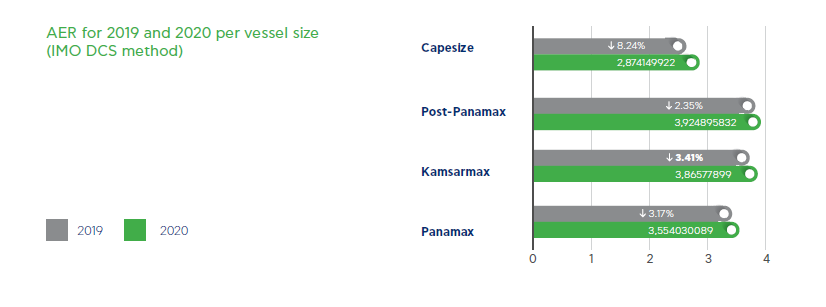Emissions
Evolution of AER per vessel size
We managed to reduce the Annual Efficiency Ratio for every segment of our fleet. The most notable improvement was observed at our Capesize vessels, where AER dropped by 8.24%.

SOX emissions
In 2020 a drastic reduction in Sulphur Oxide (SOX) emissions was recorded due to the IMO Sulphur Cap. Sulfur oxide emissions produced by our fleet in 2020 amounted to 1,404 tonnes, reduced by 75% compared to 2019. This drastic reduction is attributed partly to the adoption of compliant fuel by half of our fleet and, more importantly, to the operation of our scrubbers, which operate below 0.1% Sulfur equivalent fuel level, which is five times lower than the limit imposed by the regulation.


NOX Emissions
Nitrogen oxide (NOx) emissions produced by marine diesel engines are solely dependent on engine technology. Marine engines are categorized on Tiers, namely Tier I, Tier II, Tier III, in relation to the NOx emissions they produce. All ships with a keel-laying date later than January 1st 2016 have to comply with the IMO Tier III regulation. Currently, we operate vessels equipped with Tier I and Tier II engines. NOx emissions produced by our fleet amounted to 18,150 tonnes in 2020. As our eight newbuild vessels, which are Tier III compliant (abatement technologies such as EGR or SCR, achieving a 75% NOx reduction compared to Tier I) will be gradually delivered from 2022 to 2024, we expect to observe a significant reduction on NOx emissions.
Compliance with EU MRV & IMO DCS
We have achieved full compliance with the IMO DCS and the EU MRV regulations. We monitor our consumption emission footprint through a standardized, strict and structured process to ensure consistency and accuracy in our reporting. In addition, our vessels sailing from and to EU ports are subject to third-party verification by an accredited verifier.
- Web Design & Development by Generation Y


